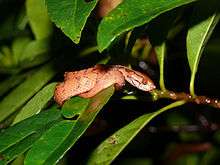Pareidae
Pareidae is a small family of snakes found largely in southeast Asia, with an isolated subfamily endemic to southwestern India. It encompasses 26 species in four genera divided into two subfamilies.[1][2]
| Pareidae | |
|---|---|
 | |
| Iwasaki's snail-eater (Pareas iwasakii) | |
| Scientific classification | |
| Kingdom: | Animalia |
| Phylum: | Chordata |
| Class: | Reptilia |
| Order: | Squamata |
| Suborder: | Serpentes |
| Clade: | Colubroides |
| Family: | Pareidae Romer, 1956 |
| Genera[1] | |
| |
Pareidae was once considered a subfamily of Colubridae (called "Pareatinae"), but it is now known that pareids are not closely related to colubrids.[3] The correct spelling is Pareidae, not Pareatidae.[4]
Many pareids are snail-eating snakes that have asymmetrical lower jaws, allowing them to pry the soft bodies of snails from their spiral shells. One species, Pareas iwasakii, has an average of 17.5 teeth in its left mandible and 25 teeth in its right mandible.[5] Other species lacking asymmetrical jaws, such as Aplopeltura boa and Asthenodipsas malaccanus, feed instead on slugs or lizards. Predation by pareids on dextral (clockwise-coiled or "right handed") snails is thought to favor the evolution of sinistral (counter-clockwise or "left handed") snails in southeast Asia, where 12% of snail species are sinistral (as opposed to 5% worldwide).[6]
Genera and species
- Subfamily Pareinae
- Aplopeltura (1 species)
- Asthenodipsas (7 species)
- Pareas (15 species)
- Subfamily Xylophiinae
- Xylophis (4 species)
References
- Pareidae at the Reptarium.cz Reptile Database. Accessed 25 April 2017.
- V. Deepak, Sara Ruane & David J. Gower (2018) A new subfamily of fossorial colubroid snakes from the Western Ghats of peninsular India, Journal of Natural History, 52:45-46, 2919-2934, DOI: 10.1080/00222933.2018.1557756
- Pyron, RA; Burbrink, F; Wiens, JJ (2013). "A phylogeny and revised classification of Squamata, including 4161 species of lizards and snakes". BMC Evolutionary Biology. 13: 93. doi:10.1186/1471-2148-13-93. PMC 3682911. PMID 23627680.
- Savage, JM (2015). "What are the correct family names for the taxa that include the snake genera Xenodermus, Pareas, and Calamaria?". Herpetological Review. 46: 664–665.
- Hoso, M; Asami, T; Hori, M (2007). "Right-handed snakes: convergent evolution of asymmetry for functional specialization". Biology Letters. 3 (2): 169–172. doi:10.1098/rsbl.2006.0600. PMC 2375934. PMID 17307721.
- Hoso, M; Kameda, Y; Wu, SP; Asami, T; Kato, M; Hori, M (2010). "A speciation gene for left-right reversal in snails results in anti-predator adaptation". Nature Communications. 1 (9): 133. doi:10.1038/ncomms1133. PMC 3105295. PMID 21139578.